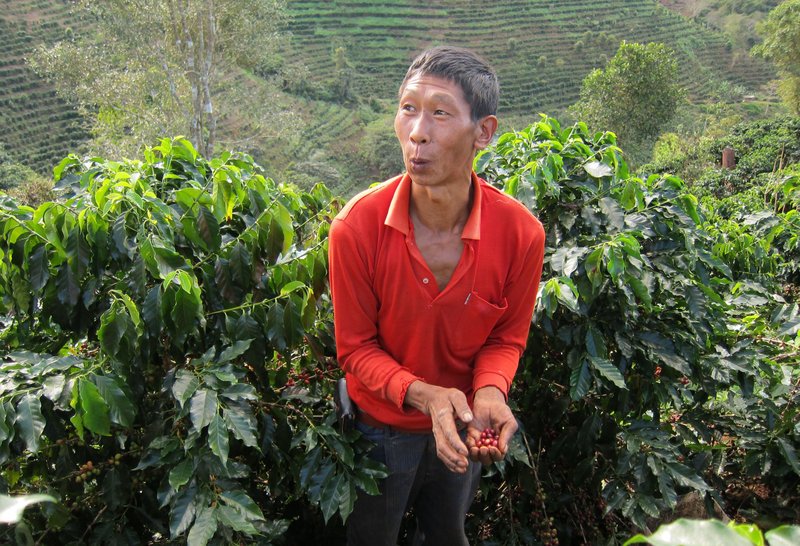PU’ER, China – This remote southwestern city near the borders of Laos and Myanmar is named after one of China’s most famous teas, grown on mountain terraces painstakingly carved out of the region’s rich red soil.
But in recent years, pu’er tea has surrendered prime real estate for a more lucrative brew: coffee. Chinese farmers have taken to the new crop, which thrives in high-altitude areas of Yunnan province and commands up to three times as much money as tea.
“My sole income depends on coffee now,” said Ma Jiaying, a farmer from a dab-size hamlet in Pu’er called Tea Tree Village.
Behind the change are major foreign producers, including Seattle’s Starbucks Corp. and Switzerland’s Nestle. Those multinationals are training farmers and buying beans from the region to meet the world’s growing thirst for coffee.
More important, Yunnan has the potential to thrive as a production base in a country that is becoming increasingly hooked on the caffeine-loaded beverage. Long dismissed by many Chinese as being too bitter, coffee has enjoyed a surge in popularity among the country’s young, urban elite.
Few pairings denote upward mobility more than an iPhone in one hand and a white-and-green Starbucks cup in the other. In central Beijing, the company’s smallest cappuccino costs about $4.33, making a Chinese Starbucks habit one of the most expensive in the world.
“Starbucks in China for the young generation is almost like religion,” said Liu Minghui, head of Pu’er-based Ai Ni Coffee, China’s largest coffee production and exporting company. “They want to be seen drinking their coffee. A lot of these Chinese kids have come back from studying overseas where they’ve been introduced to this new lifestyle.”
At 120,000 tons last year, China’s coffee consumption was only 6 percent that of the United States, the world’s top consumer of hot joe. Meanwhile, about 1 million tons of tea was consumed in China last year.
Still, analysts for Barclays expect Chinese coffee demand to grow nearly 40 percent each year until about 2015.
More stores and shops are stocking instant coffee. Nestle’s Nescafe brand has captured more than two-thirds of the Chinese market, thanks in part to blends mixed with powdered milk and sugar to make it more appealing to local palates.
Coffeehouses are percolating too; sales are projected to expand 23.5 percent annually on average to about $1.6 billion by 2016, according to Euromonitor, a global research group. Much of that growth is expected to come from Starbucks, which plans to more than double its Chinese stores to 1,500 by 2015. That would make China its second-biggest market, following the United States.
“This is a long-term commitment,” said John Culver, president of Starbucks Coffee China and Asia Pacific.
Part of that effort will be raising the profile of Yunnan coffee. Starbucks released a special blend in 2009 for Chinese consumers called South of the Clouds, which includes beans from Baoshan, a city northeast of Pu’er in Yunnan. A year later, the company partnered with Ai Ni Coffee to grow and test four coffee varietals on a plantation in Pu’er. Those beans could reach domestic and global markets in a few years.
Yunnan, considered one of the most bio-diverse regions in the world, is responsible for almost all of the roughly 60,000 tons of coffee grown in China. The provincial government has plans to increase coffee production to 200,000 tons by 2020.
But growers will have to invest heavily to guarantee consistent quality, experts said.
“It’s still very messy,” said Safi Malik, co-founder of Shangrila Farms, a boutique coffee brand that carries beans from Yunnan. “A lot of farmers don’t have training. There’s great coffee there, it just needs to be found and worked on.”
A big test is whether Chinese farmers will remain committed to the crop through price fluctuations. This year, growers are being offered about $1.20 a pound, half of what they earned two years ago.
“The best I can do this year is break even,” said Ma Xinwen, 40, who grows five acres of coffee on a hillside in Tea Tree Village about 4,000 feet above sea level.
Neighbor Ma Jiaying also worries about the lower prices, but he’s confident they will bounce back.
The 48-year-old father of two has grown coffee beans for nine years, primarily for Nestle. Every Monday and Tuesday, the company sends Ma and other farmers a text message alerting them of prices. They are free to decide whether to sell their beans.
When coffee prices surged in 2010, Ma made nearly $15,000 for the year, more money than he had ever seen in his life. He used his extra cash to build a new home.
“This year, tea may be more profitable than coffee,” said Ma, wearing flip-flops and rolled-up gray slacks. “But I don’t want to switch back. You can’t predict where prices are going to go.”
Send questions/comments to the editors.



Success. Please wait for the page to reload. If the page does not reload within 5 seconds, please refresh the page.
Enter your email and password to access comments.
Hi, to comment on stories you must . This profile is in addition to your subscription and website login.
Already have a commenting profile? .
Invalid username/password.
Please check your email to confirm and complete your registration.
Only subscribers are eligible to post comments. Please subscribe or login first for digital access. Here’s why.
Use the form below to reset your password. When you've submitted your account email, we will send an email with a reset code.